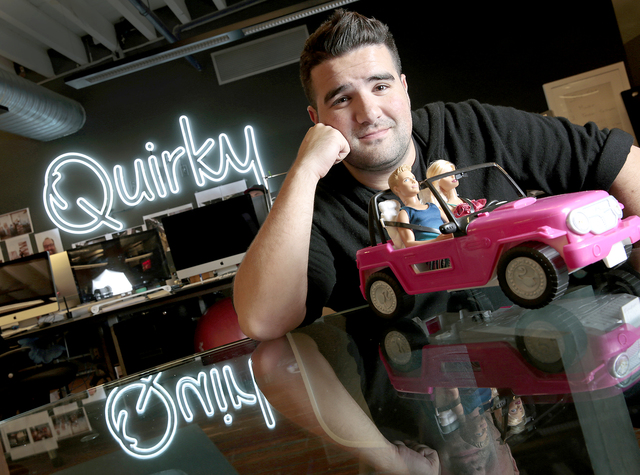Play’s still the thing as Mattel tries to inject joy back into toy making

EL SEGUNDO, Calif. — The Hot Wheels photos on a wall at Mattel’s design center are riddled with post-it notes: “Cool idea,” one says. “Like it,” goes a second, “but it’s missing something.”
ADVERTISING
And another, more bluntly: “Boring.”
There’s little mincing of words by Richard Dickson, Mattel’s chief operating officer, when he critiques ideas for new toy cars, trucks and other toys for kids. Dickson can’t worry about offending egos or wasting time, not given Mattel’s recent troubles.
It’s a radical departure for Mattel.
“The speed — there’s not a lot of discussion,” Dickson said, snapping his fingers. “We don’t even have a meeting. You don’t have to wait for anything. We can work in real time.”
For years, the company’s devotion to PowerPoint slides and layers of bureaucracy dimmed the creative spark at a business that lives and dies on hot playthings. The bottom line suffered as sales dropped for six straight quarters. Barbie sales have fallen for three years, and core brands such as Fisher-Price also struggled.
But with the ouster of Chief Executive Bryan Stockton in January, Mattel, based in this Los Angeles-area city, is trying to inject joy back into the toy-making process.
Dickson, who oversaw Barbie’s last surge in popularity around 2010, is in charge of reinventing the company. He was brought back to Mattel last year after a stint at Jones Group, and promoted to chief operating officer in April. Analysts said he is the heir apparent to Christopher Sinclair, a longtime director who took over as chief executive after Stockton.
He has a lot of work ahead. The company must strengthen its ties with entertainment companies like Disney, roll out more technologically driven products and, above all, jump-start sales.
Mattel is already taking one unconventional path toward fixing the problems: It’s outsourcing creativity. Mattel partnered with New York design firm Quirky, which functions like a sifter for inventions. Taking suggestions from around the world — everything from a gender-neutral doll to a trivia game that shoots water at losing players — Quirky will help turn out “dozens and dozens” of new toys for Mattel, said Ben Kaufman, Quirky’s chief executive.
Even though Mattel is already trying to streamline its process, Quirky believes it can help Mattel hustle toys into stores at warp speed — two or three months — compared with Mattel’s usual 16-month product cycle.
“In meetings they talk about products they want to launch in holiday 2017,” Kaufman said. “That’s not how the world works. … We can go from an idea from a mother in Alabama to a full product rollout in a couple of months.”
Although industry experts said Mattel is headed in the right direction, it’s too soon to say whether their bets will translate into hit toys.
Jaime Katz, an analyst at Morningstar, forecasts that the company will grow sales by a modest 1 percent next year. Mattel’s stock, recently hovering around $27 a share, has dropped about 44 percent since a high of $47.82 at the end of 2013.
“In the toy industry, product is king. That is the biggest area they need to fix,” said Jim Silver, editor in chief of toy review website TTPM. “But it’s not like flipping a switch. … You can’t turn it around overnight.”
Analysts and former executives describe Mattel as a company hampered by a culture that valued cost-cutting over innovation. Some critics blamed Mattel’s tendency to promote business-savvy employees instead of creative types.
Dickson readily admits that Mattel lost its way.
“We became very email-centric, we became very data-centric, we became heavy in process,” he said in a recent interview. “So what we’re trying to do is frankly have more conversations, hear about more ideas, alter different ways for ideas to rise to the top quicker.”
Dickson says his “most vital” goal is to kick-start the core brands, including American Girl, Barbie, Fisher Price and Hot Wheels. He has already reorganized the brands into separate business units and promoted people with deep backgrounds in toy design to head Barbie and Hot Wheels — jobs that traditionally, he said, would have gone to “business-oriented, marketing” types.
Within each brand, Dickson is also working to reduce the hurdles to making decisions.
The last piece of the Mattel reinvention involves strengthening its partnerships with entertainment companies.
That’s an especially important goal after Mattel was dealt a huge blow when it lost the doll licenses to Disney’s hit “Frozen” and Princess properties to rival Hasbro starting in 2016.
The problems that has plagued Mattel internally also hurt its relationship with partners like Disney, Dickson said.
“We became incredibly insular in the context of our process,” he said. “So the speed at which we were moving, the decision-making process, the fragmented approach to how we were driving brands and relationships was becoming a frustrating place to be partnered with.”
Dickson said he believes Mattel has entered its next chapter: the toddler phase. But he acknowledged there’s much more to do: “It takes a while to move culture.”


